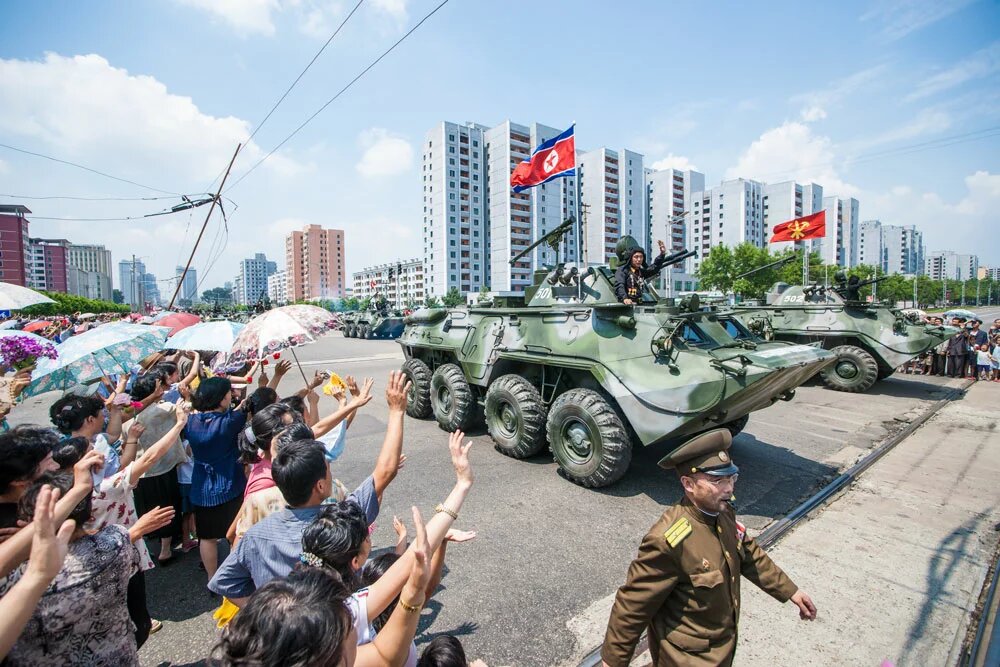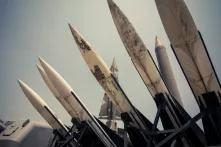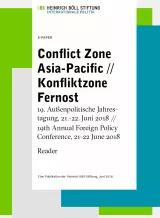In 2018, political relations on the Korean peninsula are in flux to an unprecedented degree. Taking note of the unclear situation, this article deliberately engages in speculation and develops three scenarios for the region. The author does not claim that any of these will become reality – and in certain cases strongly wishes the opposite.

In 2018, political relations on the Korean peninsula are in flux to an unprecedented degree. Back in the summer of 2017, the possibility of a friendly visit of North Korea’s Supreme Leader Kim Jong-un to South Korea would have seemed far-fetched. Even more unrealistic: the prospect of a potential summit between Kim and US President Donald Trump, openly discussing the possibility of a full de-nuclearization of the North and a lasting peace framework for both Koreas. “What is real, and what is illusion?” we might ask ourselves. Is it really possible that Kim Jong-un, after decades of strenuous efforts from North Korea to acquire nuclear weapons, and after being punished by the international community with the most rigid sanctions regime, will simply give up his ‘ultimate insurance’ policy? Would Washington truly be ready to consider withdrawing its forces from the peninsula as a result of a comprehensive peace agreement? And what could all that mean for East Asia and Europe?
At this point in time, with so many variables in flux, we can merely speculate. However, sometimes speculation is the only available means for assessing future outcomes and options. Taking note of the unclear situation, this article deliberately engages in speculation and develops three scenarios for the Korean Peninsula. The author does not claim that any of these will become reality – and in certain cases strongly wishes the opposite.
Scenario I: Diplomacy and deterrence
The Trump-Kim Summit – first anticipated, then cancelled, and finally still going ahead in Singapore – will not be short of big words and memorable images. Trump, the self-proclaimed dealmaker, will return home to the United States, just falling short of exclaiming “peace in our times” to the crowd of reporters, while no-one will know whether Kim has had a similarly enthusiastic welcome back home in Pyongyang. The next days and weeks belong to the journalists and pundits, sounding out each and every word uttered by anonymous sources at the summit sidelines. Soon, their initial praise for Trump’s “bold move” will give way to a more sober assessment, as it becomes clear that, aside from the initially stated goals of “full de-nuclearization” and “peace for both Koreas,” not much was agreed between the two alpha males. More daunting still, there is no clear and mutually shared understanding of what those goals might mean in practice and how to achieve them. Though both sides did agree on intensified and sustained diplomatic negotiations at the highest levels, there is not even a tentative roadmap with tangible interim steps.
Over the next two year the mileage account of US Secretary of State Mike Pompeo goes through the roof, as he is shuttling back and forth between Washington and East Asia. What is leaked to the press – and much is leaked thanks to the undisciplined US team – is that negotiations with the North have become quite cumbersome. Pyongyang’s diplomats are well prepared and shrewd, while Washington’s negotiators lack a clear mandate. The Department of State’s team is understaffed and lacks critical expertise. As a further complication Trump will, every now and then, send out another tweet either threatening or courting Kim who, in turn, keeps an unusually low public profile. What initially looks like concessions by the North, such as shutting down the Punggye-ri nuclear test site,1 turns out to be sophisticated Kabuki. Ever more unnerving, reports by the Japanese press call into question Kim’s lofty bid to freeze the nuclear program. More and more, it looks as though the North just wanted to buy time and capitalize on the ramifications of international recognition.
That scenario, though not entirely realistic, would have implications that could build on actual real-world trends. First, it would send a devastating signal to all other signatories of the Treaty on the Non-Proliferation of Nuclear Weapons (NPT). In effect, North Korea, being the last NPT signatory to successfully escape the regime, would not be the first to disarm. More so, having acquired nuclear weapons and subsequently gained the political recognition from the highest US echelons would demonstrate that ‘going nuclear’ has great advantages. All other adversaries of the United States, including Iran – by then perhaps still locked in a standoff with Washington over its own nuclear ambitions2 – would be closely watching. At some point, US politicians and the defense establishment might have to accept grudgingly that mutual nuclear deterrence with North Korea has become the dominant security vector for the foreseeable future.3 For the Europeans, both developments would be problematic.
On the one hand, Washington’s renewed focus on East Asia would only accelerate Obama’s famous “pivot to Asia.” The more diplomatic and military resources the United States would devote to that crucial region of the world, the less its enthusiasm to reassure its European allies or support a European Union struggling with yet another economic crisis due to a prolonged trade war with Washington. Russia, benefiting from the constantly rising oil prices that resulted from Trump’s decision to opt out of the Iran nuclear deal,4 could feel emboldened and openly court EU governments to finally recognize Moscow’s sphere of influence in Eastern Europe. Meanwhile, Berlin might resolutely debate how to take on more responsibility in an ever-changing world.
On the other hand, seeing the already moribund NPT regime further fray would run counter to established EU efforts to curb the spread of nuclear arms in a multilateral setting. This development would take place against the background of 122 states having agreed on a new Treaty on the Prohibition of Nuclear Weapons (or Ban Treaty)5 in 2017.Together, these two developments could lead to the eventual collapse of the NPT.6
Scenario II: Peace and retreat
To the great surprise of most international observers, US-North Korean talks proceed smoothly. Already in late 2018, negotiators announce a detailed plan for phasing out the North’s nuclear weapons program. Inspectors of the International Atomic Energy Agency gain access to a number of facilities in early 2019, confirming what was already known, that Pyongyang was on the cusp of acquiring a full-fledged nuclear deterrent. The Kim regime accepts to re-join the NPT and to sign the IAEA’s Additional Protocol, allowing for intrusive verification of North Korea’s soon to be peaceful nuclear program.
In exchange, Washington agrees to a peace settlement for the Korean peninsula, which includes the long-term prospect of a peaceful reunification of the two nations. One precondition set by Kim was the phased withdrawal of all US military personnel from South Korea and an end to all joint military activities, including naval exercises. While many in the United States warn Trump of such wide-ranging concessions, the White House refers to the President’s campaign pledge to scale back unnecessary and costly US security commitments around the globe. In 2020, Donald Trump and Kim Jong-un jointly receive the Nobel Peace Prize. For years to come, international relations experts struggle with how to explain such a momentous turn of events that runs against the grain of any established academic knowledge.
This scenario, though considerably less likely, would have much more far-ranging repercussions than the previous one. Perhaps most importantly, Trump’s decision to retreat from the Korean peninsula would massively alter the balance of power in East Asia, thereby strengthening Beijing’s hand in the wider Asia-Pacific region. Faced with this, close US allies such as Japan and Australia would ask themselves how much further a US retreat might proceed in years to come. In actual fact, currently there already is a lively, albeit mostly academic debate in Australia about the future of US security guarantees. One option discussed is that Canberra will develop its own nuclear deterrent in case China should win the upper hand in the Asia-Pacific.7
European governments would be confronted with a number of uncomfortable questions. Already under economic pressure from China and militarily threatened by Russia, Europeans would wonder who’s next on Trump’s retreat list. Is America’s commitment to NATO still “iron-clad?” Particularly NATO’s eastern member states might be apprehensive that the end of the Pax Americana is near. While the initial effects of North Korea renouncing nuclear arms could give a boost to the wider nonproliferation regime, a novel proliferation risk might take shape: instead of US adversaries it could be US allies that increasingly consider acquiring nuclear weapons. All the while, Berlin would still be debating how to take on more responsibility in an ever-changing world.
Scenario III: War and turmoil
It will take historians years to figure out the exact details of the spectacularly failed Trump-Kim summit. What is clear is that at one point Trump unsuccessfully tried to bully Kim into disposing of all nuclear weapons and related facilities within one year and to forego enrichment and reprocessing activities indefinitely. South Korean President Moon then called on all sides to remain calm, to rethink expectations, and to return to a policy of small and incremental steps. While Trump fires a new salvo of early-morning ‘fire and fury’ tweets and orders a large-scale military exercise in the Sea of Japan, European leaders urge Trump not to over-react, and Emmanuel Macron volunteers to mediate between the parties. Two days later, US long-range bombers and fighter jets launch a massive conventional attack against North Korean targets. That same night, Donald Trump declares that America is at war and that he was never willing to accept a nuclear-armed North Korea that was threatening to strike the US with nuclear warheads.
Contrary to previous nightmare scenarios published in the American press,8 the US military is successful in taking out all of North Korea’s nuclear-weapons capabilities. However, that does not prevent the Kim regime from wreaking havoc in the South Korean regions bordering the demilitarized zone. Seoul, in particular, suffers massive damage from the North’s conventional barrage, causing thousands of civilian casualties. While Chinese and Russian strategic nuclear forces are on high alert, the US Pacific Command announces it will not deploy boots on the ground but employ its air force to enforce a new demilitarized zone extending 30 kilometers into North Korean territory. After three weeks, the US bombing campaign is over. Kim Jong-un’s whereabouts are unknown.
This extreme case is a low probability, high impact scenario. It would plunge the world into turmoil, rattling both US adversaries and allies alike. Particularly at the outset, the Chinese leadership would be apprehensive that the US military might go into North Korea, eliminating the Kim regime and effectively taking over the North. The prospect of US forces at China’s borders – as well as at Russia’s – would cause massive regional instability and open up a number of pathways for escalation with consequences impossible to gauge. US allies in the region would be in a state of shock, having had to witness how Washington condoned massive South Korean casualties, while trying to eliminate a questionable nuclear threat to America.
The shockwaves of such an event would extend to Europe, dwarfing previous debates about proliferation or the future of the NPT. Suddenly, being allied with the United States might no longer be primarily perceived as a guarantee for one’s own freedom and security but as a potential liability. After America’s exit from the Paris climate accord, the trade war over steel tariffs, and Trump’s nixing the Iran deal, Washington, for the fourth time in a row, would have acted against EU advice and interest. Perhaps, at that point, Berlin would stop debating and start acting. Spurred by the events, Angela Merkel might seek an immediate meeting with the French President. Macron, never averse to symbolism, would await the German Chancellor onboard a Le Triomphant-class nuclear missile submarine in the Breton port of Île Longue. As usual, Merkel’s appearance would not reveal her true inner feelings.
Dr. Ulrich Kühn is a Senior Research Associate at the Vienna Center for Disarmament and Non-Proliferation and a Nonresident Scholar with the Carnegie Endowment for International Peace.
Footnotes:
1 Adam Taylor, “North Korea’s mountain mystery: Is Punggye-ri Nuclear Test Site still functional?”, The Washington Post (April 25, 2018)
2 Laurence Norman, “How Fast Iran Could Build a Nuclear Bomb”, The Wall Street Journal (May 8, 2018)
3 Uri Friedman, “Can America Live With a Nuclear North Korea?”, The Atlantic (September 14, 2017)
4 “Oil price shoots higher as Trump quits Iran nuclear deal”, Financial Times (May 9, 2018)
6 “Nearly two-thirds of U.N. states agree treaty to ban nuclear weapons”, Reuters (July 7, 2017)
6 Cf. Angela Kane and Ulrich Kühn, “Nuclear Disarmament, Arms Control, and Nonproliferation in Retreat: What Europe Can Do”, S+F Sicherheit und Frieden 36, no. 1 (2018): 40–4.
7 Tony Walker, “Why Australia might be forced to consider nuclear weapons”, The Sydney Morning Herald (January 12, 2018)
8 Jeffrey Lewis, “This is how nuclear war with North Korea would unfold”, The Washington Post (December 8, 2017)


